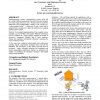492 search results - page 4 / 99 » Data Integration: Where Does the Time Go |
DAC
2003
ACM
14 years 18 days ago
2003
ACM
Fourth-generation wireless communication systems (4G) will have totally different requirements than what front-end designers have been coping with up to now. Designs must be targe...
INFOVIS
1999
IEEE
13 years 11 months ago
1999
IEEE
We examine how animating a viewpoint change in a spatial information system affects a user's ability to build a mental map of the information in the space. We found that anim...
ECCV
2000
Springer
13 years 11 months ago
2000
Springer
Abstract. Condensation is a popular algorithm for sequential inference that resamples a sampled representation of the posterior. The algorithm is known to be asymptotically correct...
VLDB
2007
ACM
14 years 1 months ago
2007
ACM
Dataspace management has been recently identified as a new agenda for information management [17, 22] and information integration [23]. In sharp contrast to standard information ...
IPSN
2009
Springer
14 years 2 months ago
2009
Springer
Data Driven Time Synchronization (DDTS) provides synchronization across sensors by using underlying characteristics of data collected by an embedded sensing system. We apply the c...

